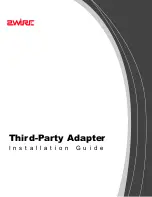
Developing Compaq COBOL Programs
1.2 Developing Programs on Tru64 UNIX
Table 1–3 lists and describes some of the software tools you can use when
developing and testing a program.
Table 1–3 Main Tools for Program Development and Testing
Task or Activity
Tool and Description
Manage source files
Use
RCS
or
sccs
to manage source files. For more information,
see the Tru64 UNIX documentation on programming support
tools or the appropriate reference page.
Create and modify
source files
Use a text editor, such as
vi
,
emacs
, or another editor. For
more information, see your operating system documentation.
Analyze source code
Use searching commands such as
grep
and
diff
. For
more information, see the Tru64 UNIX documentation on
programming support tools or the appropriate reference page.
Build program (compile
and link)
You can use the
cobol
command to create small programs,
perhaps using shell scripts, or use the
make
command to build
your application in an automated fashion using a makefile.
For more information on
make
, see the make(1) reference page
and the Tru64 UNIX documentation on programming support
tools.
Debug and test program
Use the Ladebug Debugger to debug your program or run it for
general testing. For more information on Ladebug Debugger,
see the Ladebug Debugger Manual.
Install program
Use
setld
and related commands such as
tar
. For
more information, see the Tru64 UNIX documentation on
programming support tools.
In addition, you might use the following shell commands at various times during
program development:
•
To view information about an object file or an object library, use the following
commands:
The
file
command shows the type of a file (such as which programming
language, whether it is an object library, ASCII file, and so forth).
The
nm
command (perhaps with the
-a
or
-o
flag) shows symbol table
information, including the identification field of each object file.
The
odump
command shows the contents of a file and other information.
The
size
command shows the size of the code and data sections.
For more information on these commands, see the appropriate reference page
or the DIGITAL UNIX Programmer’s Guide.
•
Use the
ar
command to create an archive object library (
-r
flag), maintain
the modules in the library, list the modules in the library (
-t
), and perform
other functions. Use
-ts
to add a table of contents to the object library for
linking purposes. For more information, see ar(1) or the DIGITAL UNIX
Programmer’s Guide.
•
To create shared libraries on Tru64 UNIX systems, use
ld
, not the
ar
command. For more information, refer to Section 1.2.3.4 and the DIGITAL
UNIX Programmer’s Guide.
1–26 Developing Compaq COBOL Programs
Содержание COBOL AAQ2G1FTK
Страница 22: ......
Страница 30: ......
Страница 94: ......
Страница 110: ......
Страница 146: ......
Страница 180: ......
Страница 194: ...Processing Files and Records 6 1 Defi...
Страница 300: ......
Страница 490: ......
Страница 516: ......
Страница 517: ......
Страница 530: ......
Страница 534: ......
Страница 590: ......
Страница 620: ......
















































